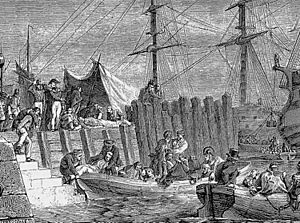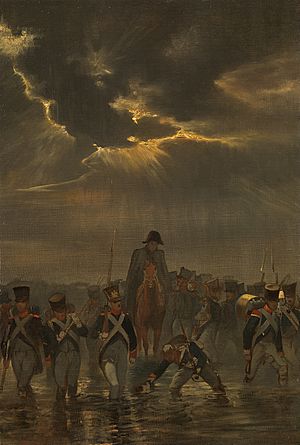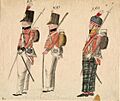Walcheren Campaign facts for kids
Quick facts for kids Walcheren Campaign |
|||||||
|---|---|---|---|---|---|---|---|
| Part of the War of the Fifth Coalition | |||||||
 Illness-stricken British troops evacuating the island of Walcheren on 30 August. |
|||||||
|
|||||||
| Belligerents | |||||||
| Commanders and leaders | |||||||
| Strength | |||||||
| July: 20,000 August: 46,000 |
39,000 616 ships |
||||||
| Casualties and losses | |||||||
| 4,000 dead, wounded or captured (including 1st battalion, Irish legion) 5,000+ sick |
4,150 dead, wounded or captured 12,000+ sick |
||||||
The Walcheren Campaign was a British military trip to the Netherlands in 1809. It was part of the War of the Fifth Coalition, where the Austrian Empire was fighting against France. The British hoped to open a new battlefront to help the Austrians.
The main goals were to capture the cities of Flushing and Antwerp in the Netherlands. They also wanted to control the Scheldt River. About 39,000 soldiers and 15,000 horses sailed across the North Sea. They landed on the island of Walcheren on July 30. This was the largest British military trip that year. It was even bigger than the army fighting in Portugal.
However, the campaign did not succeed. There was not much fighting, but many soldiers got sick. This illness was called "Walcheren Fever." More than 4,000 British troops died during the campaign, but only 106 died in battle. The remaining soldiers left on December 9.
Contents
Why the Walcheren Campaign Happened
In July 1809, the British wanted to block the mouth of the Scheldt River. This would stop the French from using the port of Antwerp as a base against them. A main goal was to destroy the French fleet, which they thought was in Flushing. They also wanted to distract the French, who were putting a lot of pressure on the Austrians.
However, the big battle of Battle of Wagram had already happened before the British even started their campaign. The Austrians had pretty much lost the war by then.
John Pitt, 2nd Earl of Chatham led the army, and Sir Richard Strachan commanded the navy. Their huge force of 37 ships, the biggest ever to leave England, set sail on July 28.
The Campaign in Action
First, the British took over the swampy island of Walcheren and South Beveland island. Both are in what is now the Netherlands. Soon, British soldiers started getting sick with "Walcheren fever." This sickness was probably a mix of malaria, typhus, typhoid, and dysentery.
Within a month of taking the island, over 8,000 soldiers had the fever. The medical supplies for the trip were not enough. This was surprising because reports had shown that a French army there a few years earlier had lost 80% of its soldiers to disease.
At the start, the French forces were not well organized. They had soldiers from many different countries that France had taken over. Some French units were not very strong, made up of sick or less trained soldiers.
However, on August 10, 1809, more French soldiers arrived. Napoleon then put Marshal Jean-Baptiste Bernadotte in charge of the whole area. Bernadotte was a brilliant organizer and trainer. He brought much-needed unity to the French command.
Even though the British captured Flushing on the day Bernadotte arrived, he had already moved the French fleet to Antwerp. He also sent many more soldiers to defend Antwerp. The French now had so many soldiers that the British could not reach their main goal, Antwerp. The British decided to stop the campaign in early September. About 12,000 British soldiers stayed on Walcheren, but by October, only 5,500 were healthy enough to fight.
What Happened After
The British government spent almost £8 million on this campaign. Besides the 4,000 men who died, nearly 12,000 were still sick by February 1810. Many others were permanently weakened. Soldiers sent to join Wellington's army in Portugal caused the number of sick soldiers there to double.
This campaign also led to a plant called Thanet cress being brought to Britain. It came in the sick men's bedding. The failure of the campaign caused a lot of political problems for the British government.
Irish Legion's Role
The 1st battalion of the Irish Legion was a group of Irish soldiers fighting for France. They were in Flushing during the attack. They fought bravely for several days but were almost all captured. A small group of Irishmen managed to hide with their important "imperial eagle" flag. After a few days, they crossed the Scheldt River and escaped. Their commander, Lawless, and Captain O'Reilly were later honored by Napoleon.
See also
Images for kids




